A Multi-Dimensional Assessment of Pocket Park Landscapes: Insights from Scenic Beauty Estimation and Analytic Hierarchy Process in Dadukou District, Chongqing
Abstract
1. Introduction
2. Materials and Methods
2.1. Study Area Overview
2.2. Develop a Park Scenic Quality Assessment System
- Field surveys were conducted during the summer months (July–August), taking into account seasonal and practical considerations. July was identified as the optimal month for photography to ensure favorable weather conditions. Photographs were captured between 8:30–11:30 a.m. and 12:00–4:30 p.m., leveraging the best possible lighting conditions. The camera was positioned at a height of 1.6 m, equivalent to the human eye level, to standardize the visual perspective. In each park, three photographs were taken from various positions and angles to minimize the impact of extraneous elements, such as people or the surrounding environment, on the visual quality of the landscapes (Figure S1).
- After completing the field data collection, the research team developed, distributed, and collected the questionnaires in August 2024. The survey participants comprised 48 landscape professionals and 49 non-professionals. A seven-point scale was utilized to assess scenic beauty as the primary evaluation metric. A total of 106 questionnaires were returned, of which 97 were considered valid, resulting in a response efficiency rate of 91.5%. The standardization formula for the SBE method is as follows:These variables are used to evaluate and standardize scenic beauty. Rij represents the raw score given by the jth evaluator for the ith landscape, which reflects the evaluator’s direct judgment. Rj is the average score assigned by the evaluator across all landscapes, which helps adjust for differences in scoring standards among evaluators. Sj is the standard deviation of all scores given by the evaluator, indicating the consistency or variability of the ratings. Zij is the standardized score given by the jth evaluator for the ith landscape, calculated to eliminate differences in scoring scales and variability. Finally, Zi is the overall standardized score for the ith landscape, representing its comprehensive scenic beauty. These variables enable the model to objectively compare the aesthetic qualities of different landscapes.
- Decomposition of Landscape Elements: Research on pocket park landscapes has provided valuable insights, with scholars examining key elements from various perspectives. Luks [20] analyzed the influence of cultural elements on the identity of Detroit’s pocket parks, elucidating the intricate relationship between culture and landscape design in this context. Marcus et al. [22] investigated how plant diversity influences the composition of urban open-space plant communities. Forsyth et al. [48] emphasized the importance of recreational facility layout and spatial openness in enhancing user experiences in small parks. Peschardt et al. [34] identified essential factors such as layering, harmony, naturalness, and color diversity, highlighting their contributions to creating an inviting atmosphere and promoting health. Additional studies by Wang et al. [42] demonstrated how the integration of water features with plant landscapes enhances the visual appeal of Nanjing’s waterfront parks, while Li et al. [49] assessed factors such as shading, planting techniques, plant health, ornamental value, and the green view index in their analysis of plant landscape quality in Nanning’s floral parks. Given the challenges posed by Chongqing’s topography, water elements are rarely incorporated into its pocket parks. This research synthesizes findings from prior studies and focuses on landscape evaluation to identify 11 landscape factors suitable for evaluating pocket parks in Dadukou District, Chongqing (Table 4).
- Establishment of the Evaluation Model: Multiple linear regression analysis was performed using Excel and SPSS software (version 26.0). The backward elimination method was employed to iteratively exclude insignificant landscape factors, culminating in the retention of the most influential factors affecting the scenic beauty scores. Subsequently, the relationship between the SBE calculation results and the retained landscape factors was analyzed. This analysis facilitated the construction of a final evaluation model.
2.3. Analytical Hierarchy Process Method (AHP)
- Construction of a Comprehensive Plant Landscape Evaluation System: To enhance the scientific validity and reliability of the evaluation system, 28 preliminary indicators were initially selected [49,53,54,55,56,57,58,59,60]. A panel of 15 experts from fields such as landscape design, ecology, and landscape economics—each with an average of over 10 years of professional experience—was convened. The Delphi method was employed in two rounds to refine the indicators. In the absence of direct evidence, the Delphi method provides a scientific decision-making tool to ensure the scientific validity and reliability of the results [61]. The Delphi method has been widely applied to establish evaluation systems and determine indicators. By repeatedly consulting a group of independent experts, it systematically collects and synthesizes opinions to reach a consensus and make forecasts, ultimately leading to more objective and comprehensive conclusions [62]. In the first round, the experts anonymously rated the importance of the 28 indicators using a questionnaire. The coefficient of variation was calculated to assess the consensus level among experts, with indicators showing a coefficient below 0.25 being considered to have reached an agreement [63,64]. After screening, 20 indicators were retained. During the second round, experts received feedback on the results of the first round and were requested to refine their rankings and ratings of the indicators. Through further analysis of the weighted average scores and coefficients of variation, 15 final evaluation indicators were established (Table 5). The finalized indicators were categorized into four criteria: landscape function, ecological function, service function, and economic benefits. Landscape function includes five factors, ecological function comprises four, service function also encompasses four, and economic benefits are represented by two factors. Collectively, these categories create a multi-level, comprehensive evaluation framework for pocket park landscapes in Dadukou District.
| Criterion Layer (B) | Factor Layer (C) | References |
|---|---|---|
| B1 Landscape Function | C1 Plant Color Richness | Peng (2018) [53] |
| C2 Seasonal Variation in Plant Appearance | Ye, Y. (2016) [54] | |
| C3 Green View Index | Yin, X et al. (2013) [55] | |
| C4 Environmental Cleanliness | Nordh et al. (2013) [56] | |
| C5 Landscape Style Compatibility with Surroundings | Feng, X. et al. (2013) [57] | |
| B2 Ecological Function | C6 Plant Diversity | Robinson (2006) [58] |
| C7 Community Nativeness | Wu, S (2017) [59] | |
| C8 Plant Health Condition | Li, L et al. (2020) [49] | |
| C9 Low Maintenance of Plant Landscape | Zheng, W.K. et al. (2023) [60] | |
| B3 Service Function | C10 Spatial Safety | Nordh et al. (2013) [56] |
| C11 Comfort of Facilities and Landscape | Pasha et al. (2013) [65] | |
| C12 Targeted Services for Specific User Groups | Ma, X. et al. (2022) [66] | |
| C13 Educational Value of Plant Landscape | Li, L et al. (2020) [49] | |
| B4 Economic Benefits | C14 Initial Site Renovation Cost | Zheng, W.K. et al. (2023) [60] |
| C15 Post-Renovation Maintenance Cost | Zheng, W.K. et al. (2023) [60] |
- Determining the Weights of Evaluation Indicators: Initially, 25 experts were invited to assess the relative importance of 15 evaluation indicators (e.g., plant color richness and seasonal variation) using a pairwise comparison method on a scale of 1–9. The scores were then averaged to construct a comprehensive judgment matrix. Subsequently, the maximum eigenvalue (λmax) and corresponding weight vector were calculated using eigenvalue decomposition. A consistency test is performed, involving the calculation of the consistency index (CI = (λmax – n)/(n – 1)) and the consistency ratio (CR = CI/RI), where RI represents the random consistency index. If CR < 0.1, the matrix is deemed consistent; otherwise, adjustments are necessary, and the process is repeated [67]. Finally, the normalized matrix is employed to determine the final weights of each indicator, thus providing a scientific foundation for the comprehensive evaluation.
- The Comprehensive Plant Landscape Evaluation Index is calculated to quantify the overall quality of plant landscapes based on weighted evaluation factors. Each evaluation factor is assigned a weight (Wi) derived from the AHP, which reflects its relative importance in the assessment. Additionally, each factor is scored (Fi) based on its performance, with scores of 3, 5, 7, and 9 representing low, moderate, good, and excellent quality, respectively. The comprehensive evaluation index (B) is calculated as the sum of the products of the weights and corresponding scores, expressed by the following formula [68,69]:
- To standardize the evaluation, the Comprehensive Evaluation Index (CEI) is derived using the following formula:where S represents the actual score obtained from the evaluation and S0 is the ideal maximum score representing perfect performance [70]. The CEI provides a percentage-based measure of plant landscape quality, enabling standardized comparisons across different sites. Based on the CEI, plant landscapes are classified into four grades: Grade I (CEI > 80%), Grade II (70% ≤ CEI ≤ 80%), Grade III (60% ≤ CEI ≤ 70%), and Grade IV (CEI < 60%). The last CEI for each bag area was calculated using the mean of three pictures, providing a brief and accurate landscape assessment.
3. Results and Analysis
3.1. Reliability and Validity Analysis of the Questionnaire
3.2. Scenic Beauty Scores and Evaluation Model
3.2.1. Analysis of SBE Scores for Each Park
3.2.2. Establishing the Evaluation Model
3.3. Analysis of Evaluation Indicator Weights
3.4. Calculation of Comprehensive Plant Landscape Evaluation Index
4. Discussion
4.1. Research Background and Spatial Quality Evaluation
4.2. Research Findings and Analysis of Influencing Factors
5. Conclusions
6. Recommendations
- Optimize landscape design by incorporating biophilic principles: The SBE results reveal that factors such as spatial layering, plant diversity, landscape harmony, and color richness are crucial for aesthetic appeal, with color richness being the most significant. In the design process, it is imperative to incorporate natural elements that foster a deeper human-nature connection, such as strategically positioning vegetation of diverse heights and leveraging the park’s topographical features to create visually engaging vertical layers, particularly within Dadukou’s mountainous terrain. Enhancing plant diversity through a balanced composition of trees, shrubs, and grasses, while selecting species that are well-adapted to the local environment, will contribute to ecological resilience and biodiversity enhancement. Furthermore, integrating biophilic design principles, such as the use of natural materials and organic patterns, into the park layout can reinforce the symbiotic relationship between individuals and the natural world. This can be achieved by emphasizing color coordination, using complementary or analogous colors, and incorporating color into elements like pavements, seating, and lighting to create a harmonious and visually appealing environment.
- While no significant correlation between park size and aesthetic appeal was found, the limited size of pocket parks demands efficient and meticulous planning. Functional areas should be strategically designed to optimize space usage. For instance, combining fitness zones with landscape elements can optimize spatial efficiency. Furthermore, park designs should be tailored to their specific locales and surrounding contexts to address the varied needs of different user demographics. Considering the significance of public aesthetics, as evidenced by the SBE results, community engagement is indispensable. Employing participatory approaches, such as surveys and community workshops, is crucial to ensure that the design resonates with residents’ preferences. Additionally, implementing a comprehensive long-term maintenance strategy, encompassing routine plant care practices like pruning, irrigation, fertilization, and pest management, is essential to preserving plant vitality and sustaining the park’s aesthetic integrity.
7. Limitations
Supplementary Materials
Author Contributions
Funding
Institutional Review Board Statement
Informed Consent Statement
Data Availability Statement
Acknowledgments
Conflicts of Interest
References
- Geng, D.; Innes, J.; Wu, W.; Wang, G. Impacts of COVID-19 pandemic on urban park visitation: A global analysis. J. For. Res. 2021, 32, 553–567. [Google Scholar] [CrossRef] [PubMed]
- Saunders, D. We Learn to Fight This Thing Together by Keeping Parks Open. The Globe and Mail, 10 April 2020. [Google Scholar]
- Pan, F.; Wang, X. Insights for the Planning and Management of Urban Parks in the United States During the COVID-19 Pandemic. Beijing Plan. Rev. 2020, 4, 47–49. [Google Scholar]
- Dong, J.; Guo, F.; Lin, M.; Zhang, H.; Zhu, P. Optimization of Green Infrastructure Networks Based on Potential Green Roof Integration in a High-Density Urban Area—A Case Study of Beijing, China. Sci. Total Environ. 2022, 834, 155307. [Google Scholar] [CrossRef] [PubMed]
- Scopelliti, M.; Carrus, G.; Adinolfi, C.; Suarez, G.; Colangelo, G.; Lafortezza, R.; Panno, A.; Sanesi, G. Staying in Touch with Nature and Well-Being in Different Income Groups: The Experience of Urban Parks in Bogotá. Landsc. Urban Plan. 2016, 148, 139–148. [Google Scholar] [CrossRef]
- Chiang, Y.C.; Li, D. Metric or Topological Proximity? The Associations Among Proximity to Parks, the Frequency of Residents’ Visits to Parks, and Perceived Stress. Urban For. Urban Green. 2019, 38, 205–214. [Google Scholar] [CrossRef]
- Chiesura, A. The role of urban parks for the sustainable city. Landsc. Urban Plan. 2004, 68, 129–138. [Google Scholar] [CrossRef]
- Hung, K.; Crompton, J. Benefits and Constraints Associated with the Use of an Urban Park Reported by a Sample of Elderly in Hong Kong. Leis. Stud. 2006, 25, 291–311. [Google Scholar] [CrossRef]
- Wang, P.; Zhou, B.; Han, L.; Mei, R. The Motivation and Factors Influencing Visits to Small Urban Parks in Shanghai, China. Urban For. Urban Green. 2021, 60, 127086. [Google Scholar] [CrossRef]
- Ma, T.T. Research on the Evaluation and Optimization Design of Pocket Park Spatial Quality in Mountainous Urban Areas. Master’s Thesis, Chongqing Jiaotong University, Chongqing, China, 2024. [Google Scholar]
- Morris, N. Health, Well-Being and Open Space: Literature Review. OPEN Space: The Research Centre for Inclusive Access to Outdoor Environments; Edinburgh College of Art and Heriot-Watt University: Edinburgh, Scotland, 2003. [Google Scholar]
- Wilson, E.O. Biophilia; Harvard University Press: Cambridge, MA, USA, 1984. [Google Scholar]
- Nisbet, E.K.; Zelenski, J.M.; Murphy, S.A. The Nature Relatedness Scale: Linking Individuals’ Connection with Nature to Environmental Concern and Behavior. Environ. Behav. 2009, 41, 715–740. [Google Scholar] [CrossRef]
- Fuller, R.; Irvine, K.N. Interactions Between People and Nature in Urban Environments. In Urban Ecology; Gaston, K.J., Ed.; Cambridge University Press: New York, NY, USA, 2010. [Google Scholar]
- Keniger, L.E.; Gaston, K.J.; Irvine, K.N.; Fuller, R.A. What Are the Benefits of Interacting with Nature? Int. J. Environ. Res. Public Health 2013, 10, 913–935. [Google Scholar] [CrossRef]
- Kellert, S.R. Dimensions, Elements, and Attributes of Biophilic Design. In Biophilic Design: The Theory, Science, and Practice of Bringing Buildings to Life; Kellert, S.R., Ed.; Wiley: Hoboken, NJ, USA, 2008; pp. 3–19. [Google Scholar]
- Kellert, S.R. Building for Life: Designing and Understanding the Human-Nature Connection; Island Press: Washington, DC, USA, 2005. [Google Scholar]
- Kellert, S.R.; Heerwagen, J.; Mador, M. Biophilic Design: The Theory, Science and Practice of Bringing Buildings to Life; Wiley: Hoboken, NJ, USA, 2013; ISBN 978-0-470-16334-4. [Google Scholar]
- Blake, A. Pocket Parks. Open Space Seattle 2013, 2100, 1. [Google Scholar]
- Luks, J. Focus Hope: A Pocket Park Study, Detroit, MI. Inq. Univ. Ark. Undergrad. Res. J. 2001, 2, 96–100. [Google Scholar]
- Faraci, P. Vest Pocket Parks; American Psychological Association: Washington, DC, USA, 1967; Available online: https://www.planning.org/pas/reports/report229/ (accessed on 5 June 2024).
- Marcus, C.C.; Francis, C. People Places: Design Guidelines for Urban Open Space; John Wiley & Sons: New York, NY, USA, 1997. [Google Scholar]
- Park, J.; Kim, J.-H.; Lee, D.K.; Park, C.Y.; Jeong, S.G. The Influence of Small Green Space Type and Structure at the Street Level on Urban Heat Island Mitigation. Urban For. Urban Green. 2017, 21, 203–212. [Google Scholar] [CrossRef]
- Xing, Y.; Brimblecombe, P. Trees and Parks as ‘The Lungs of Cities’. Urban For. Urban Green. 2020, 48, 126552. [Google Scholar] [CrossRef]
- Gholami, Y.; Taghvaei, S.H.; Norouzian-Maleki, S.; Mansouri Sepehr, R. Identifying the Stimulus of Visual Perception Based on Eye-Tracking in Urban Parks: Case Study of Mellat Park in Tehran. J. For. Res. 2021, 26, 91–100. [Google Scholar] [CrossRef]
- Schebella, M.F.; Weber, D.; Schultz, L.; Weinstein, P. The Wellbeing Benefits Associated with Perceived and Measured Biodiversity in Australian Urban Green Spaces. Sustainability 2019, 11, 802. [Google Scholar] [CrossRef]
- Jasmani, Z.; Mohamad, S.; Hamid, A.R.; van den Bosch, C.C.K. Planning and Design Considerations for Birds and Butterflies’ Diversity of Small Urban Parks: A Case of Petaling Jaya, Malaysia. Alam Cipta 2020, 13, 69–81. [Google Scholar]
- Bartolo, R. Escapes to Nature: Pocket Parks and Intimate Green Spaces Around Manhattan. Sculpt. Rev. 2021, 70, 17–35. [Google Scholar] [CrossRef]
- Zhou, X.; Parves Rana, M. Social Benefits of Urban Green Space: A Conceptual Framework of Valuation and Accessibility Measurements. Manag. Environ. Qual. 2012, 23, 173–189. [Google Scholar] [CrossRef]
- Salih, S.A.; Ismail, S.; Mseer, A. Pocket Parks for Promoting Social Interaction Among Residents of Baghdad City. Archnet-IJAR 2020, 14, 393–408. [Google Scholar] [CrossRef]
- Lorenzo, E.; Corraliza, J.A.; Collado, S.; Sevillano, V. Preference, Restorativeness and Perceived Environmental Quality of Small Urban Spaces. PsyEcology 2016, 7, 152–177. [Google Scholar] [CrossRef]
- Ikin, K.; Beaty, R.M.; Lindenmayer, D.B.; Knight, E.; Fischer, J.; Manning, A.D. Pocket Parks in a Compact City: How Do Birds Respond to Increasing Residential Density? Landsc. Ecol. 2013, 28, 45–56. [Google Scholar] [CrossRef]
- Lau, S.S.Y.; Yang, F.; Tai, J.; Wu, X.L.; Wang, J. The Study of Summer-Time Heat Island, Built Form, and Fabric in a Densely Built Urban Environment in Compact Chinese Cities: Hong Kong, Guangzhou. Int. J. Sustain. Dev. 2011, 14, 30. [Google Scholar] [CrossRef]
- Peschardt, K.K.; Stigsdotter, U.K. Evidence for Designing Health Promoting Pocket Parks. Archnet-IJAR 2014, 8, 149–164. [Google Scholar] [CrossRef]
- Ministry of Housing and Urban-Rural Development. Notice of the General Office of the Ministry of Housing and Urban-Rural Development on Promoting the Construction of “Pocket Parks”; Ministry of Housing and Urban-Rural Development: Beijing, China, 2022. Available online: https://www.gov.cn/zhengce/zhengceku/2022-08/09/content_5704766.htm (accessed on 6 December 2024).
- Chongqing Municipal Urban Management Bureau. 62 New Pocket Parks Opened! 100 Pocket Parks to Be Completed by the End of This Year; Chongqing Municipal Urban Management Bureau: Chongqing, China, 2024. Available online: https://www.cq.gov.cn/ywdt/zwhd/bmdt/202408/t20240813_13495758.html (accessed on 26 May 2024).
- Daniel, T.; Boster, R. Measuring Landscape Esthetics: The Scenic Beauty Estimation Method; USDA Forest Service: Fort Collins, CO, USA, 1976. [Google Scholar]
- Utami, R.N.; Irwan, S.N.R.; Setyawan, Y. Assessing Visual Quality of Landscape on Roadside Greenery in Yogyakarta City, Indonesia. Int. Rev. Spat. Plan. Sustain. Dev. 2022, 10, 256–279. [Google Scholar] [CrossRef] [PubMed]
- Wang, Y.; Yang, G.; Lu, Y. Evaluation of Urban Wetland Landscapes Based on a Comprehensive Model—A Comparative Study of Three Urban Wetlands in Hangzhou, China. Environ. Res. Commun. 2023, 5, 035004. [Google Scholar] [CrossRef]
- Min, J.; Pan, T. Landscape Evaluation of Forest Park Based on Analytic Hierarchy Process. Math. Probl. Eng. 2022, 2022, 7496570. [Google Scholar] [CrossRef]
- Sang, K.; Fontana, G.L.; Piovan, S.E. Assessing Railway Landscape by AHP Process with GIS: A Study of the Yunnan-Vietnam Railway. Remote Sens. 2022, 14, 603. [Google Scholar] [CrossRef]
- Wang, X.; Gao, X.; Liang, Y. Quantitative Research on Waterside Plant Landscapes Based on the SBE Analysis Method: A Case Study of Nanjing Waterfront Park. Chin. Landsc. Archit. 2020, 36, 122–126. [Google Scholar] [CrossRef]
- Yang, J.; Wei, W. Comprehensive Evaluation of Autumn Landscape in Heilongtan Park, Kunming, Based on the Scenic Beauty Estimation Method. Landsc. Archit. 2021, 38, 93–99. [Google Scholar]
- Chen, C.; Yang, S.; Yan, L. Construction of Plant Landscape Evaluation System in Residential Areas of Liuzhou City Based on AHP. J. Cent. South Univ. For. Technol. 2014, 34, 134–140. [Google Scholar]
- Kang, X. Plant Landscape Evaluation of Eight Park Green Spaces in Guilin City Based on AHP. J. Northwest For. Univ. 2018, 33, 273–278. [Google Scholar]
- Peng, G.R. New Chongqing: Focusing on Urban Renewal, Dadukou’s Quiet “Metamorphosis”. New Chongqing—Chongqing Daily, 2 December 2024. Available online: https://cqrb.cn/contry/dy20/2024-12-02/2102244_pc.html (accessed on 6 December 2024).
- Li, X.; Jia, L.; Hao, X. Scenic Beauty Estimation (SBE) Evaluation Method for Forest Landscapes. Chin. Urban For. 2007, 3, 33–36. [Google Scholar]
- Forsyth, A. The Planned Communities of Irvine, Columbia, and The Woodlands; University of California Press: Berkeley, CA, USA, 2005. [Google Scholar]
- Li, L.; He, T. Plant Landscape Evaluation of Nanning’s Flower Park Based on SBE and AHP Methods. For. Invent. Plan. 2020, 45, 187–194. [Google Scholar] [CrossRef]
- Sun, Y.C.; Yang, Y.Y.; Wu, Y.X.; Feng, R.Z.; Cheng, S.T. Evaluation and Analysis of Arbor Greening Tree Species in Yan’an Urban Area Based on the AHP Method. Anhui Agric. Sci. Bull. 2021, 27, 75–78. [Google Scholar]
- Forman, E.H.; Gass, S.I. The Analytic Hierarchy Process—An Exposition. Oper. Res. 2001, 49, 469–486. [Google Scholar] [CrossRef]
- Franek, J.; Kresta, A. Judgment Scales and Consistency Measure in AHP. Procedia Econ. Financ. 2014, 12, 164–173. [Google Scholar] [CrossRef]
- Peng, H.Y.; Tan, S.H. Study on the influencing mechanism of restoration effect of urban park environment: A case study of chongqin. Chin Landsc. Archi. 2018, 34, 5–9. [Google Scholar]
- Ye, Y. Research on Plant Landscape of Waterfront Linear Parks in Fuzhou. Master’s Thesis, Fujian Agriculture and Forestry University, Fuzhou, China, 2016. [Google Scholar]
- Yin, X.; Zhang, D.; Lin, S.H.; Lin, W.Q.; Lin, Y.Y.; Tang, K. Study on the Evaluation of Forest Landscape Quality in Forest Parks Based on the SBE and AHP Methods. For. Environ. Sci. 2023, 39, 59–71. [Google Scholar]
- Nordh, H.; Hartig, T.; Hagerhall, C.M.; Fry, G. Components of small urban parks that predict the possibility for restoration. Urban For. Urban Green. 2009, 8, 225–235. [Google Scholar] [CrossRef]
- Feng, X.; Lei, Y.; Zhang, Y. Plant Landscape Evaluation of Residential Areas in Wuhan City Based on the AHP Method. Anhui Agric. Sci. 2021, 49, 92–97. [Google Scholar]
- Robinson, N. The Planting Design Handbook; Routledge: London, UK, 2017; ISBN 9781315554655. [Google Scholar]
- Wu, S. Evaluation and Optimization of Plant Landscape Quality in Parks and Green Spaces in Xuhui District, Shanghai. Master’s Thesis, East China University of Science and Technology, Shanghai, China, 2017. [Google Scholar]
- Zheng, W.K.; Chen, J. Plant landscape evaluation of pocket park in Xuhui District of Shanghai based on SBE and AHP. J. Shanghai Norm. Univ. Nat. Sci. 2023, 52, 507–514. [Google Scholar]
- Rowe, G.; Wright, G.; Bolger, F. Delphi: A reevaluation of research and theory. Technol. Forecast. Soc. Change 1991, 39, 235–251. [Google Scholar] [CrossRef]
- Goodman, C.M. The Delphi Technique: A Critique. J. Adv. Nurs. 1987, 12, 729–734. [Google Scholar] [CrossRef]
- Xie, L.; Feng, M.; Cheng, J.; Huang, S. Developing a Core Competency Training Curriculum System for Emergency Trauma Nurses in China: A Modified Delphi Method Study. BMJ Open 2023, 13, e066540. [Google Scholar] [CrossRef] [PubMed]
- Wang, X.; Chen, T.; Zhang, Y.; Yang, H.H. Implications of the Delphi Method in the Evaluation of Sustainability Open Education Resource Repositories. Educ. Inf. Technol. 2021, 26, 3825–3844. [Google Scholar] [CrossRef]
- Pasha, S.; Shepley, M.M. Research note: Physical activity in pediatric healing gardens. Landsc. Urban Plan. 2013, 118, 53–58. [Google Scholar] [CrossRef]
- Ma, X.M.; Li, S.Y. Psychological Safety Perception of Park Activity Spaces Based on AHP-AIP Method. J. Shenyang Jianzhu Univ. Soc. Sci. 2022, 24, 28–34. [Google Scholar]
- Saaty, R.W. The Analytic Hierarchy Process—What It Is and How It Is Used. Math. Model. 1987, 9, 161–176. [Google Scholar] [CrossRef]
- Han, Y.; Liu, Y. Evaluation for Plant Landscape Configuration of Urban Road Based on Comprehensive Evaluation Index Method—A Case Study of Yanhu District in Yuncheng City. For. Inventory Plan. 2019, 44, 213–219. [Google Scholar]
- Liu, Y.; Zhao, J.; Li, X.; Lei, Y.; Kong, D. Comprehensive Evaluation of the Landscape of the Plant Communities in Longzi Lake Park in Zhengzhou Based on AHP and SBE Methods. J. Northwest For. Univ. 2021, 36, 250–257. [Google Scholar]
- Refshauge, A.D.; Stigsdotter, U.K.; Cosco, N.G. Adults’ Motivation for Bringing Their Children to Park Playgrounds. Urban For. Urban Green. 2012, 11, 396–405. [Google Scholar] [CrossRef]
- George, D.; Mallery, P. SPSS for Windows Step by Step: A Simple Guide and Reference; Allyn & Bacon: Boston, MA, USA, 2002. [Google Scholar]
- Kaiser, H.F. An Index of Factorial Simplicity. Psychometrika 1974, 39, 31–36. [Google Scholar] [CrossRef]
- Kaczynski, A.T.; Potwarka, L.R.; Saelens, B.E. Association of Park Size, Distance, and Features with Physical Activity in Neighborhood Parks. Am. J. Public Health 2008, 98, 1451–1456. [Google Scholar] [CrossRef] [PubMed]
- Cohen, D.A.; Han, B.; Derose, K.P.; Williamson, S.; Marsh, T.; Raaen, L.; McKenzie, T.L. The Paradox of Parks in Low-Income Areas: Park Use and Perceived Threats. Environ. Behav. 2016, 48, 230. [Google Scholar] [CrossRef]
- Ge, S. Analysis of the Significance and Planning Design of Urban Pocket Parks. Jiangxi Agric. J. 2012, 03, 18–22. [Google Scholar]
- Zeng, W.; Feng, Y.; Zeng, L. Landscape Evaluation of Seven Pocket Parks in Quanzhou Based on AHP Method. Landsc. Archit. 2020, 12, 54. [Google Scholar]
- Kutner, M.H.; Nachtsheim, C.J.; Neter, J.; Li, W. Applied Linear Statistical Models, 5th ed.; McGraw-Hill: New York, NY, USA; Irwin: New York, NY, USA, 2004. [Google Scholar]
- Gujarati, D.N. Basic Econometrics, 4th ed.; McGraw-Hill: Boston, MA, USA, 2003; Available online: https://zalamsyah.staff.unja.ac.id/wp-content/uploads/sites/286/2019/11/7-Basic-Econometrics-4th-Ed.-Gujarati.pdf (accessed on 6 December 2024).
- Liu, J.Y.; Guo, H.X. Evaluation of Plant Landscape in Xingtai Waterfront Park Based on AHP Method. Xiandai Hortic. 2023, 46, 22–24. [Google Scholar]
- Zhu, J.S.; Wang, X.J.; Zhang, J.X.; Wang, Y.; Yuan, S. Evaluation of Winter Plant Scenery in Urban Parks of Beijing Based on the SBE-SD Method. Beijing For. Univ. 2024, 7, 22–23. [Google Scholar]
- Gooood. Pak Tsz Lane Park, Hong Kong. Gooood, 26 September 2013. Available online: https://www.gooood.cn/pak-tsz-lane-park.htm (accessed on 13 January 2025).
- Jia, S.H.; Zhang, J.G. Evaluation of Plant Landscape in Urban Historical and Cultural Parks Based on the Scenic Beauty Degree Evaluation Method: A Case Study of Luobinwang Park in Yiwu. For. Investig. Des. 2024, 53, 59–67. [Google Scholar]
- People’s Daily Online. Extraordinary Ten Years|The City in the Park, People in the Painting—Huangpu Moves Towards a “City in a Park”. People’s Daily Online, 9 December 2022. Available online: http://sh.people.com.cn/n2/2022/1209/c134768-40225602.html (accessed on 13 January 2025).
- Guangzhou Daily. Small Pocket Parks, Full of Lingnan Style. Guangzhou Yuexiu District People’s Government, 3 November 2022. Available online: https://www.yuexiu.gov.cn/yxdt/rdzt/jsmlyx/yxtxc/content/post_8652179.html (accessed on 13 January 2025).
- Liu, Y.Y.; Li, S.; Wu, Z.; Wang, P.F. Evaluation of Plant Landscape in Zhengzhou Beilonghu Wetland Park Based on AHP and SBE Methods. For. Inventory Plan. 2024, 49, 68–75. [Google Scholar]



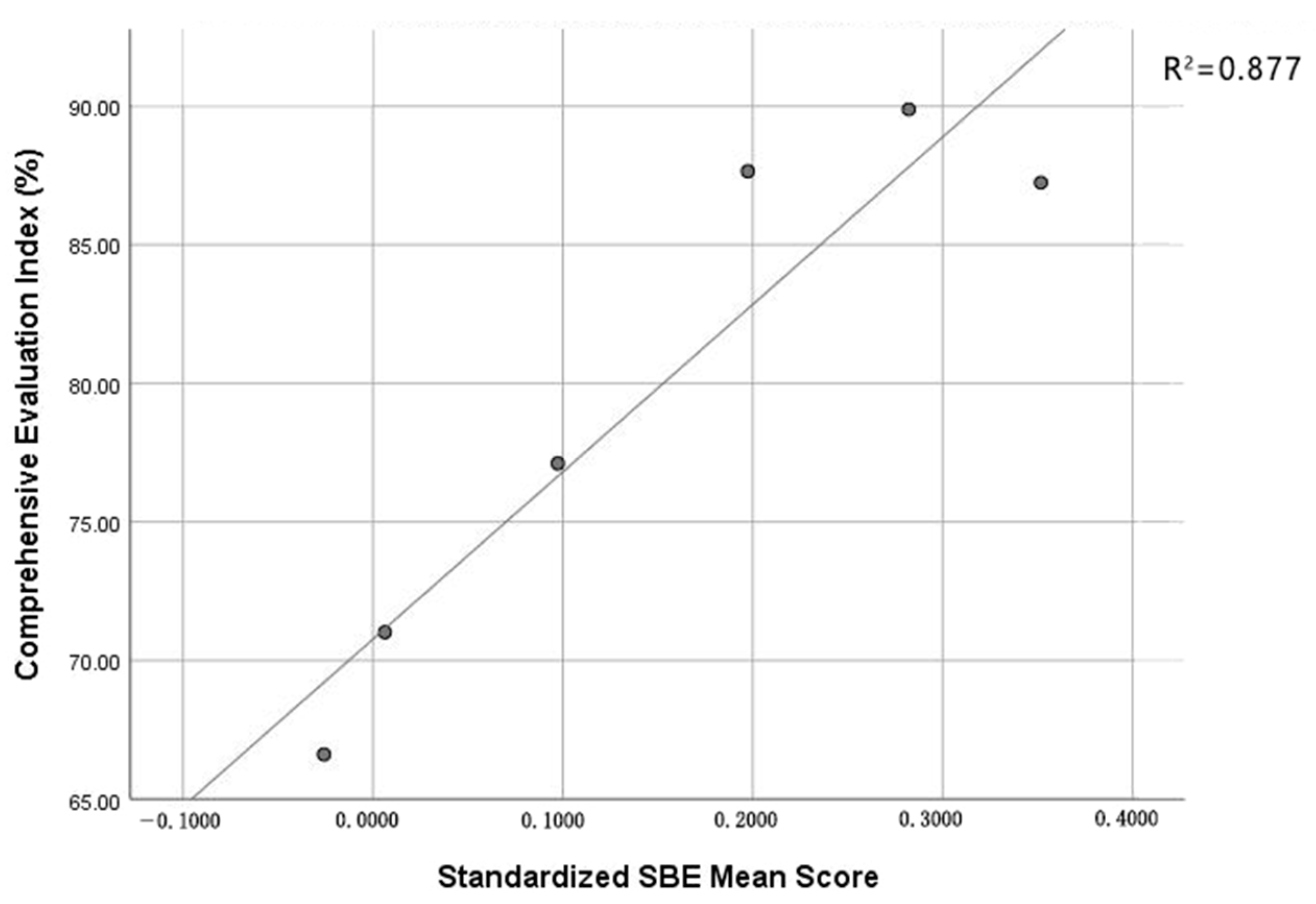
| Spatial Location Type | Plan Diagram | Site Diagram |
|---|---|---|
| Slope | 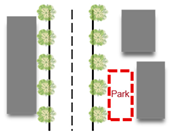 | 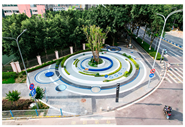 |
| Block | 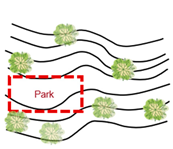 | 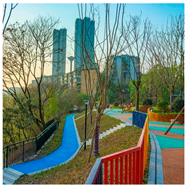 |
| Under-bridge |  |  |
| Types of Spatial Undulations | Degree of Undulation | Section Diagram | Site Diagram |
|---|---|---|---|
| Flat Land | 0~5 m |  | 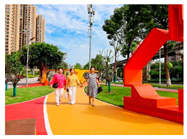 |
| Gentle Slope | 5~10 m |  | 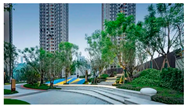 |
| Steep Slope | ≥10 m | 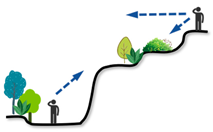 | 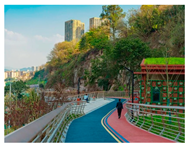 |
| Park | Site Photos | Area (m2) | Location | Location Type | Space Type | Terrain Type |
|---|---|---|---|---|---|---|
| Steel Park | 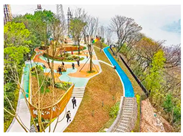 | 8000 | Yuejin Village Subdistrict, Gangtie Road, Hao’er Mountain Top | Slope | Open | Steep Slope |
| Longqiao Pocket Park | 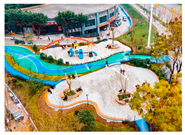 | 2000 | No. 102 Diaoyuzui Avenue, Longqiao Garden Community | Block | Open | Gentle |
| Vegetable Commune | 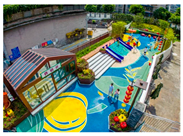 | 500 | Between No. 60 Songqing Avenue and Jinxing Complex Building | Block | Open | Gentle |
| Xingfuli Park | 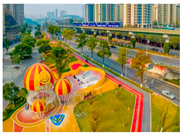 | 9500 | Baijia Garden Community, Jiansheng Town | Block | Closed | Gentle |
| Happy Yuli Garden |  | 2300 | Yuejin Village Subdistrict, Gangtie Community | Slope | Semi-Open | Gentle Slope |
| Huangjue Memory Park | 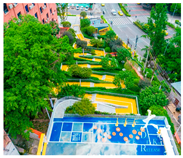 | 2500 | Next to Huangjue Building, Ganghua Road | Slope | Open | Steep Slope |
| No. | Landscape Element | Landscape Element | ||
|---|---|---|---|---|
| 1 | Shade Coverage (X1) | Exposed to Sunlight | —— | Shaded |
| 2 | Landscape Hierarchy (X2) | Lack of Layers | —— | Rich in Layers |
| 3 | Green View Index (X3) | Low Green Coverage | —— | High Green Coverage |
| 4 | Planting Methods (X4) | Formal Planting | —— | Informal Planting |
| 5 | Plant Growth Condition (X5) | Poor Growth | —— | Healthy Growth |
| 6 | Ornamental Characteristics of Plants (X6) | Non-Ornamental | —— | Highly Ornamental |
| 7 | Plant Diversity (X7) | Single Plant Species | —— | Rich Plant Species |
| 8 | Landscape Harmony (X8) | Inharmonious | —— | Harmonious |
| 9 | Color Richness (X9) | Monotonous Colors | —— | Rich Colors |
| 10 | Landscape Naturalness (X10) | Unnatural | —— | Natural |
| 11 | Spatial Characteristics (X11) | Enclosed | —— | Open |
| Park | Sample No. | SBE Score | SBE Mean Score | Park | Sample No. | SBE Score | SBE Mean Score |
|---|---|---|---|---|---|---|---|
| Vegetable Commune | 1 | 0.0022 | 0.0063 | Longqiao Pocket Park | 10 | −0.0134 | −0.0258 |
| 2 | 0.0111 | 11 | −0.0527 | ||||
| 3 | 0.0057 | 12 | −0.0114 | ||||
| Xingfuli Park | 4 | 0.0743 | 0.0973 | Huangjue Memory Park | 13 | 0.1784 | 0.2821 |
| 5 | 0.1155 | 14 | 0.2875 | ||||
| 6 | 0.1021 | 15 | 0.3803 | ||||
| Happy Yuli Garden | 7 | 0.2703 | 0.3517 | Steel Park | 16 | 0.1228 | 0.1974 |
| 8 | 0.4249 | 17 | 0.0624 | ||||
| 9 | 0.3600 | 18 | 0.4069 |
| Number of Iterations | R | R2 | Adjusted R2 | Standard Estimation Error |
|---|---|---|---|---|
| 1 | 0.950 a | 0.902 | 0.723 | 0.1178 |
| 2 | 0.950 b | 0.902 | 0.763 | 0.1091 |
| 3 | 0.950 c | 0.902 | 0.792 | 0.1022 |
| 4 | 0.949 d | 0.901 | 0.813 | 0.0967 |
| 5 | 0.949 e | 0.900 | 0.831 | 0.0921 |
| 6 | 0.947 f | 0.897 | 0.841 | 0.0893 |
| 7 | 0.944 g | 0.891 | 0.846 | 0.0878 |
| 8 | 0.938 h | 0.880 | 0.843 | 0.0886 |
| Coefficients | Effect Coefficients | Standard Error | Beta | t | Sig. | Tolerance | VIF |
|---|---|---|---|---|---|---|---|
| X2 | 0.221 | 0.066 | 0.481 | 3.358 | 0.005 | 0.450 | 2.223 |
| X7 | 0.185 | 0.055 | 0.363 | 3.370 | 0.005 | 0.796 | 1.256 |
| X8 | 0.094 | 0.044 | 0.216 | 2.168 | 0.049 | 0.930 | 1.075 |
| X9 | 0.276 | 0.073 | 0.513 | 3.768 | 0.002 | 0.499 | 2.003 |
| Criterion Layer (B) | Criterion Layer Weight Value | Factor Layer (C) | Factor Layer Weight Value | Comprehensive Weight Value |
|---|---|---|---|---|
| B1 Landscape Function | 0.6686 | C1 Plant Color Richness | 0.2257 | 0.1509 |
| C2 Seasonal Variation in Plant Appearance | 0.1345 | 0.0899 | ||
| C3 Green View Index | 0.1268 | 0.0848 | ||
| C4 Environmental Cleanliness | 0.0979 | 0.0655 | ||
| C5 Landscape Style Compatibility with Surroundings | 0.0837 | 0.0560 | ||
| B2 Ecological Function | 0.2144 | C6 Plant Diversity | 0.0840 | 0.0180 |
| C7 Community Nativeness | 0.0441 | 0.0095 | ||
| C8 Plant Health Condition | 0.0446 | 0.0096 | ||
| C9 Low Maintenance of Plant Landscape | 0.0417 | 0.0089 | ||
| B3 Service Function | 0.0882 | C10 Spatial Safety | 0.0331 | 0.0029 |
| C11 Comfort of Facilities and Landscape | 0.0183 | 0.0016 | ||
| C12 Targeted Services for Specific User Groups | 0.0189 | 0.0017 | ||
| C13 Educational Value of Plant Landscape | 0.0180 | 0.0016 | ||
| B4 Economic Benefits | 0.0289 | C14 Initial Site Renovation Cost | 0.0139 | 0.0004 |
| C15 Post-Renovation Maintenance Cost | 0.0150 | 0.0004 |
| Park | Comprehensive Evaluation Index B | Comprehensive Evaluation Index (%) | Grade |
|---|---|---|---|
| Huangjue Memory Park | 4.06 | 89.88 | I |
| Steel Park | 3.96 | 87.65 | I |
| Happy Yuli Garden | 3.94 | 87.24 | I |
| Xingfuli Park | 3.48 | 77.11 | II |
| Vegetable Commune | 3.21 | 71.02 | II |
| Longqiao Huayuan Pocket Park | 3.01 | 66.61 | III |
| Analysis | R | R2 | Adjusted R2 | Sig. |
|---|---|---|---|---|
| Correlation Analysis (SBE and CEI) | 0.936 a | 0.877 | 0.846 | 0.006 |
Disclaimer/Publisher’s Note: The statements, opinions and data contained in all publications are solely those of the individual author(s) and contributor(s) and not of MDPI and/or the editor(s). MDPI and/or the editor(s) disclaim responsibility for any injury to people or property resulting from any ideas, methods, instructions or products referred to in the content. |
© 2025 by the authors. Licensee MDPI, Basel, Switzerland. This article is an open access article distributed under the terms and conditions of the Creative Commons Attribution (CC BY) license (https://creativecommons.org/licenses/by/4.0/).
Share and Cite
Peng, X.; Mohamed Afla, M.R. A Multi-Dimensional Assessment of Pocket Park Landscapes: Insights from Scenic Beauty Estimation and Analytic Hierarchy Process in Dadukou District, Chongqing. Sustainability 2025, 17, 2020. https://doi.org/10.3390/su17052020
Peng X, Mohamed Afla MR. A Multi-Dimensional Assessment of Pocket Park Landscapes: Insights from Scenic Beauty Estimation and Analytic Hierarchy Process in Dadukou District, Chongqing. Sustainability. 2025; 17(5):2020. https://doi.org/10.3390/su17052020
Chicago/Turabian StylePeng, Xinyi, and Mohamad Reza Mohamed Afla. 2025. "A Multi-Dimensional Assessment of Pocket Park Landscapes: Insights from Scenic Beauty Estimation and Analytic Hierarchy Process in Dadukou District, Chongqing" Sustainability 17, no. 5: 2020. https://doi.org/10.3390/su17052020
APA StylePeng, X., & Mohamed Afla, M. R. (2025). A Multi-Dimensional Assessment of Pocket Park Landscapes: Insights from Scenic Beauty Estimation and Analytic Hierarchy Process in Dadukou District, Chongqing. Sustainability, 17(5), 2020. https://doi.org/10.3390/su17052020






